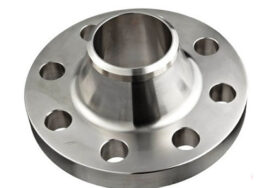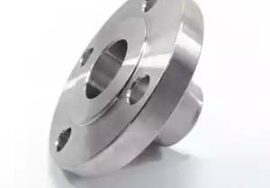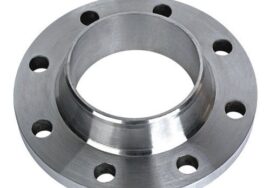
Stainless steel 316 flanges
Why go with 316 stainless steel flanges?
316 stainless steel flanges are very strong, resilient to corrosion, and able to withstand extreme pressure.
In comparison to other metals, it has a high level of corrosion resistance. Internal piping system corrosion is caused by the flow of liquid and gas through oil pipelines.
Strength: Any liquid or gas flow tool’s weak point is usually the weld fitting and junction. Molybdenum and titanium additions strengthen the material and reduce its propensity to distort.
Versatility: It may be applied in a variety of indoor and outdoor settings and is suitable for a wide range of applications.
It is capable of withstanding high temperatures and pressures. The ASTM A182 F316 flange is suitable for usage in temperatures ranging from 500 to 800°C.
Value: When used in liquid and gas flow with the pipe system, it is extremely robust and may endure for ten years. Because of its resilience to corrosion, it requires little maintenance and doesn’t need to be replaced for many years.
SA 182 grade F316 slip on flanges and ASTM A182 F316 blind flange manufacturer in India
What specifications apply to flanges made of SA 182 Gr F316?
The standards listed below are frequently used with stainless steel flanges and include the following:
The ASTM A182 standard covers rolled or forged piping system elements intended for operation in high-temperature environments, while ASME B16.5 specifies the dimensions for stainless steel pipe flanges and flange fittings.
ASME B16.47 is for large-diameter stainless steel flanges.
ASME B16.34 is a pressure rating used for threaded and welded valves used to connect flanges.
The minimum material specifications and dimensions for stainless steel flange used in stainless steel pipe systems are outlined in AWWA C228.
Get high-quality 316 stainless steel flanges at competitive prices from a trusted manufacturer in India, at Aesteiron we offer MTC EN 10204 type 3.1 to ensure perfect material
How are 316 SS flanges made?
Three primary processes are used to create 316 SS flanges: casting, cutting rolled plate, and forging. The primary step in the fabrication of flanges is the processing of raw materials and then falling them into the proper specifications.
Raw material: Before being purchased, it goes through a rigorous testing and approval procedure. The chemical and physical characteristics that aid in confirming that the material satisfies the minimal requirements of your intended application are disclosed in the Mill Test Report.
Melted metal is first poured into a mould to create the correct flange shape during the casting process. The casting is taken out of the mould once the liquid metal has solidified, and it is subsequently machined to the appropriate proportions and surface polish.
Cutting: To thin the material and achieve the appropriate plate thickness, the procedure starts with flattening the stainless steel stock using rollers. Next, a laser, flame, or water jet is used to cut it to the appropriate outer and inner diameter. After cutting the necessary grinder and bolt holes, the flange is further machined to precise specifications.
ASTM A182 F316 Specification
| Standard Specifications | ASTM A182 F316 / ASME SA 182 grade F316 (SS 316 forged flanges) |
| ASTM A240 F316 / ASME SA 240 grade F316 (SS 316 plate flanges) | |
| Dimensions | ANSI/ASME B16.5, ASME B16.47 Series A & B, and ASME B16.48 |
| Manufacturing Standards | BS (British Standard) |
| DIN, EN (European Standards ss 316 flanges manufacturer) | |
| ASA/ANSI/ASME B16.5/16.36/16.47A/16.47B | |
| API 605 | |
| B16.48 | |
| MSS S44 | |
| EN-1092 | |
| GOST Flange | |
| B16.47 Series A & B | |
| ISO 70051 | |
| JIS B2220 | |
| BS1560-3.1 | |
| EN 1092 | |
| API 7S-15 | |
| BS 10 | |
| API 7S-43 | |
| BS4504 | |
| Manufacturing Range | 1/2" (15 NB) to 48" (1200NB) DN10~DN5000 or custom sizes & design as per drawing |
| Pressure Class | 150 to 2500 |
| Material of Origin | West Europe / Japan / USA / Korean |
| Types of SS 316 flanges we produce at Aesteiron | ASTM A182 F316 forged flange |
| A240 F316 plate flange | |
| ASTM A182 Gr F316 blind flange | |
| ASTM A182 Grade F316 weld neck flange | |
| ASME SA182 F316 slip on flange | |
| SA182 Gr F316 socket weld flange | |
| 316 stainless steel threaded flange | |
| Stainless steel 316 lap joint flange | |
| SS 316 SORF flange | |
| AISI 316 WNRF flange | |
| SUS 316 LWNRF flange | |
| DIN 1.4401 orifice flange | |
| UNS S31600 RTJ flange | |
| and many others |
What are the major differences between ASTM A182 F316 and A182 F316L material?
Here are 6 major differences between ASTM A182 F316 and A182 F316L including cost
| ASTM A182 F316 | ASTM A182 F316L | |
| Maximum carbon content | 0.08% | 0.03% |
| Corrosion-resistant | highly corrosion-resistant | more resistant to corrosion |
| Weldability | good weldability | better weldability |
| Cost | less expensive | more expensive compared to SA 182 grade 316 |
| Mechanical properties | higher tensile strength | slightly higher tensile strength |
| Applications | suitable for high-temperature resistance eg. chemical and petrochemical sectors | suitable for high corrosion resistance eg pharmaceutical and food sectors |
SS 316 Blind flange Chemical Composition
| C | Mn | Si | P | S | Cr | Mo | Ni | N | |
| 316 | 0.08 | 2 | 0.75 | 0.045 | 0.03 | min: 16.0 | min: 2.0 | min: 10.0 | 0.1 |
| (S31600) | max | max | max | max | max | max: 18.0 | max: 3.0 | max: 14.0 | max |
| 316L | 0.03 | 2 | 0.75 | 0.045 | 0.03 | min: 16.0 | min: 2.0 | min: 10.0 | 0.1 |
| (S31603) | max | max | max | max | max | max: 18.0 | max: 3.0 | max: 14.0 | max |
| 316TI(S31635) | - | - | - | - | - | 16 | 2 | 10 | - |
| 0.08 | 2 | 0.75 | 0.045 | 0.03 | 18 | 3 | 14 | 0.1 |
MECHANICAL PROPERTIES OF STAINLESS STEEL 316
| Grade | Tensile Strengthksi (min) | Yield Strength 0.2% ksi (min) | Elongation % | Hardness (Brinell) MAX | Hardness(Rockwell B) MAX |
| 316 (S31600) | 75 | 30 | 40 | 217 | 95 |
| 316L(S31603) | 70 | 25 | 40 | 217 | 95 |
| 316TI(S31635) | 515(Mpa) | 205(Mpa) | 35 | 205 | 75 |





